A New Device to Place Elastic Separators
Bhuwan Saklecha1, Pawankumar Dnyandeo Tekale2, Chetan O Agarwal3, Arun Mhaske4, Harshal Patil5
1 Senior Lecturer, Department of Orthodontics, Index Institute of Dental Sciences, Indore, Madhya Pradesh, India.
2 Senior Lecturer, Department of Orthodontics, Dr. Rajesh Ramdasji Kambe Dental College and Hospital, Akola, Maharashtra, India.
3 Private Practice, Pune, Maharashtra, India.
4 Senior Lecturer, Department of Orthodontics, Dr D.Y. Patil Dental School, Lohegaon, Pune, Maharashtra, India.
5 Post Graduate Student, Department of Orthodontics, ACPM Dental CollegeDhule, Maharashtra, India.
NAME, ADDRESS, E-MAIL ID OF THE CORRESPONDING AUTHOR: Dr. Pawankumar Dnyandeo Tekale, Director and Orthodontist, Dnyanita Orthodontic care, Aurangabad, Maharashtra, India.
E-mail: pawan0804@gmail.com
Separation of teeth is an important and integral aspect of orthodontic treatment. Elastomeric separators are the most common devices used today which require special instrument to place them. The purpose of this study was to design a separator placing instrument of dental probe/explorer which can be used as an alternative to the special instrument required. The materials required were two dental probes/explorers, a light wire plier and elastomeric separators. The modified instrument made is easy to fabricate, inexpensive and can partially or completely replace the special separator placing plier.
Modified dental probe,Orthodontic treatment
Introduction
Separation of teeth is an important and integral aspect of orthodontic treatment. The goal is to simply create space around the tooth to be banded, so that the band can be seated properly in the second appointment. To create this space, the orthodontist places a small elastic separator in between the teeth to be banded. The orthodontic bands are recommended in cases of partially erupted molars, the molar teeth having large amalgam or composite restoration, or in case of prosthesis on the molar teeth such as metal or ceramic crown. The cases which require headgear, palatal expander, lingual arch or trans-palatal arch, the orthodontic bands are required.
There are mainly five types of separators used today. TP springs, latex elastics/elastomeric separator, plastic modules, brass wire and NEET springs [1]. Plastic and brass wire separators are not used often today as they were used earlier [1].
These elastomeric separators require special instrument to stretch them first and then pass through the contact until the gingival portion of the separator passes through the contact point [2].
In case of unavailability of this special separator placing plier for example in dental clinics where orthodontist is not available full time or separator placing plier is broken/unavailable, the use of elastomeric separator becomes difficult. So, the purpose was to design a separator placing instrument of commonest dental instrument i.e. dental probe/explorer so that one can use it in case the special separator placing plier is unavailable.
Materials and Methods
Materials
The materials required were - Two dental probes/explorers, Light wire plier/Young’s universal plier, Elastomeric separators.
Methods
The steps of making this new separator placing instrument are as follows:-
With the help of light wire plier or Young’s universal plier, the dental probe/explorer is modified by bending its tip starting from its shanks toward its handle by 180° such that tip is parallel to its handle.
The tip is further bent by 180° inwards as shown in [Table/Fig-1] so that it doesn’t hurt the patient. The same procedure is repeated for the second probe/explorer.
The tip of the dental probe was bent in 180 degree
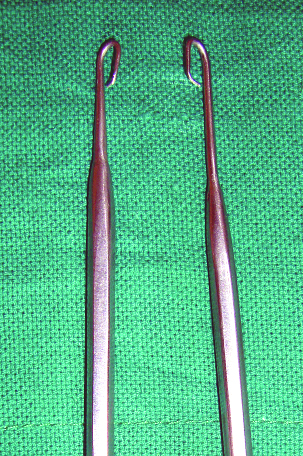
The steps of placing separator with this new instrument are as follows:-
The elastomeric separator is engaged into the end of one of the modified probes and then into the other [Table/Fig-2].
The elastic separator is stretched by pulling the two modified probes away from each other [Table/Fig-3].
With the help of bucco-lingual, to and fro movements the elastic separator is placed through the contact points of the two teeth [Table/Fig-4,5].
The elastomeric separator is engaged into the end of one of the modified probes
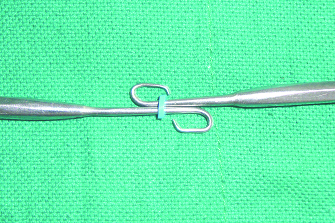
The elastic separator is stretched by pulling the two modified probes away from each other
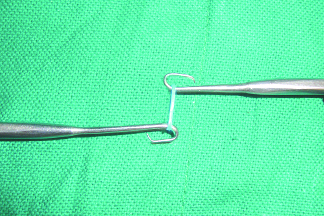
Intraoral photographs while placing separators with modified dental probe in patient’s mouth
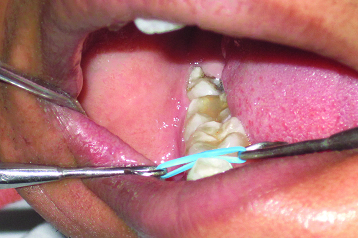
Intraoral photographs showing the separators placed in patient’s mouth
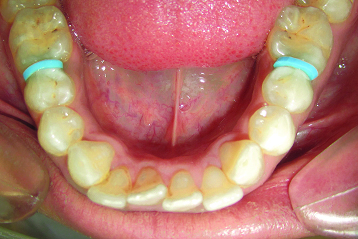
Discussion
This article describes the new separator placing device. There is general agreement that adequate separation between teeth is necessary for good band adaption [3,4]. Angle discussed the need for separation in 1907, and his method is still popular today [3]. Oliver stated the reasons necessary for the sufficient space between the teeth to be banded. He stated some of the reasons such as to lower physical pain to the lowest possible degree, to prevent injury to the tooth structure due to excess pressure while banding or band placement and to avoid distortion of the band material by not, having to force it unduly to position during band fabrication [5].
The separator placing pliers are routinely used for placing elastomeric separators; these pliers are available in market [6]. The separator placing device is less expensive than those pliers and the device can be fabricated from dental probe or explorers that are easily available in dental clinics. The device described in the article is simple, economical and can be easily fabricated. Most of the times, the elastomeric separators get dislodged during eating and needed to be placed again prior to orthodontic molar band placement. So the dentist can easily place the elastomeric separators with the help of this separator placing device. Sometimes, it is difficult to place elastomeric separators with the separator placing device in the tight contacts, for which the separator placing plier is necessary.
It also reduces the number of visits of orthodontist and chances of trauma to the adjacent soft tissues as this device gives more control on stretch of separator using this device with both hands of the dentist. Hence the cost, availability and fabrication are overcome by this device. Till date, no such device has been fabricated.
The advantages of using this modified instrument are:-
It is easy to fabricate.
Inexpensive.
It reduces the number of visits of orthodontist visiting a dental clinic especially in country side area.
It eliminates the use of special separator placing plier.
While using this device with two hands, it gives more control over stretch of the elastomeric separator, thus avoiding the trauma to intraoral soft tissues if separator breaks.
Disadvantages
There is need of two people for use of this device, one for retraction of cheek and other for placing the separator with this device.
If separators are placed according to this method, sometimes they don’t even enter in the tight contacts for which the separator placing plier is necessary.
Conclusion
The elastic separator placing device is economical, effective and it can be fabricated from dental probe/explorer that is easily available at dental clinics. Due to control over stretch of the elastic separator, while placing separator in patient’s mouth, there are less chances of trauma to adjacent soft tissues. Though there are couple of disadvantages; but looking at the cost, availability and fabrication; all these factors makes this separator placing device the partial substitution to the separator placing plier.
[1]. Cureton SL, Bice RW, Comparison of three types of separators in adult patients J Clin Orthod 1997 31(3):172-77. [Google Scholar]
[2]. McGann DB, A nickel titanium separating spring J Clin Orthod 1991 25:315-18. [Google Scholar]
[3]. Angle Edward H, Treatment of malocclusion of the teeth 1907 PhiladelphiaR. 8. White Dental Mfg. co [Google Scholar]
[4]. Anderson George M, Practical orthodontics 1960 St. LouisThe CV Mosby Company [Google Scholar]
[5]. Hoffman WE, A study of four types of orthodontic separator Angel Orthod 1972 42(3):67-73. [Google Scholar]
[6]. Anisha V, Jyothikiran H, Ravi S, Patel P, Orthodontic Separators – A systemic review Journal of Orofacial & Health Sciences 2014 5(3):118-22. [Google Scholar]